Ghaznavids
The Ghaznavid dynasty (Persian: غزنویان ġaznaviyān) was a Persianate[5] Muslim dynasty of Turkic mamluk origin,[6][lower-alpha 2][7] at their greatest extent ruling large parts of Iran, Afghanistan, much of Transoxiana and the northwest Indian subcontinent from 977 to 1186.[8] The dynasty was founded by Sabuktigin upon his succession to rule of the region of Ghazna after the death of his father-in-law, Alp Tigin, who was a ex-general of the Samanid Empire from Balkh, north of the Hindu Kush in Greater Khorasan.
Ghaznavid Empire غزنویان ġaznaviyān | |||||||||||||||||
|---|---|---|---|---|---|---|---|---|---|---|---|---|---|---|---|---|---|
| 977–1186 | |||||||||||||||||
.PNG.webp) Ghaznavid Empire at its greatest extent in 1030 CE | |||||||||||||||||
| Status | Empire | ||||||||||||||||
| Capital | Ghazni (977–1163) Lahore (1163–1186) | ||||||||||||||||
| Common languages | Persian[lower-alpha 1] (official and court language; lingua franca) Arabic (theology) Turkic (military)[2] | ||||||||||||||||
| Religion | Sunni Islam | ||||||||||||||||
| Government | Empire | ||||||||||||||||
| Sultan | |||||||||||||||||
• 977–997 | Sabuktigin (first) | ||||||||||||||||
• 1160–1186 | Khusrau Malik (last) | ||||||||||||||||
| Vizier | |||||||||||||||||
• 998–1013 | Abu'l-Hasan Isfaraini (first mentioned) | ||||||||||||||||
• 12th century | Abu'l-Ma'ali Nasrallah (last mentioned) | ||||||||||||||||
| Historical era | Medieval | ||||||||||||||||
• Established | 977 | ||||||||||||||||
• Disestablished | 1186 | ||||||||||||||||
| Area | |||||||||||||||||
| 1029 estimate[3][4] | 3,400,000 km2 (1,300,000 sq mi) | ||||||||||||||||
| |||||||||||||||||
Although the dynasty was of Central Asian Turkic origin, it was thoroughly Persianised in terms of language, culture, literature and habits[lower-alpha 3][9][lower-alpha 4][10] and hence is regarded as a "Persian dynasty".[11]
Sabuktigin's son, Mahmud of Ghazni, declared independence from the Samanid Empire[12] and expanded the Ghaznavid Empire to the Amu Darya, the Indus River and the Indian Ocean in the east and to Rey and Hamadan in the west. Under the reign of Mas'ud I, the Ghaznavid dynasty began losing control over its western territories to the Seljuq dynasty after the Battle of Dandanaqan, resulting in a restriction of its holdings to modern-day Afghanistan, Pakistan (Punjab and Balochistan).[13][14] In 1151, Sultan Bahram Shah lost Ghazni to the Ghurid king Ala al-Din Husayn.
Rise to power
Two military families arose from the Turkic slave-guards of the Samanid Empire, the Simjurids and Ghaznavids, who ultimately proved disastrous to the Samanids. The Simjurids received an appanage in the Kohistan region of eastern Khorasan. The Samanid generals Alp Tigin and Abu al-Hasan Simjuri competed for the governorship of Khorasan and control of the Samanid Empire by placing on the throne emirs they could dominate after the death of Abd al-Malik I in 961. His death created a succession crisis between his brothers. A court party instigated by men of the scribal class – civilian ministers rather than Turkic generals – rejected the candidacy of Alp Tigin for the Samanid throne. Mansur I was installed instead, and Alp Tigin prudently retired to south of the Hindu Kush, where he captured Ghazna and became the ruler of the city as a Samanid authority.[8] The Simjurids enjoyed control of Khorasan south of the Amu Darya but were hard-pressed by a third great Iranian dynasty, the Buyid dynasty, and were unable to survive the collapse of the Samanids and the subsequent rise of the Ghaznavids.
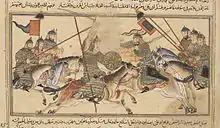
The struggles of the Turkic slave generals for mastery of the throne with the help of shifting allegiance from the court's ministerial leaders both demonstrated and accelerated the Samanid decline. Samanid weakness attracted into Transoxiana the Karluks, a Turkic people who had recently converted to Islam. They occupied Bukhara in 992, establishing in Transoxania the Kara-Khanid Khanate.
After Alp Tigin's death in 963, Abu Ishaq Ibrahim, followed by his slave Sabuktigin, took the throne. Sabuktigin's son Mahmud of Ghazni made an agreement with the Kara-Khanid Khanate whereby the Amu Darya was recognised as their mutual boundary.
Domination
Sabuktigin
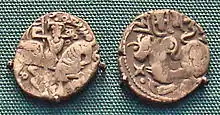
Sabuktigin, son-in-law of Alp Tigin and founder of the Ghaznavid Empire, began expanding it by capturing Samanid, Lawik, and Kabul Shahi territories, including most of what is now Afghanistan and part of Pakistan. The 16th century Persian historian, Firishta, records Sabuktigin's genealogy as descended from the Sasanian kings: "Subooktu-geen, the son of Jookan, the son of Kuzil-Hukum, the son of Kuzil-Arslan, the son of Ferooz, the son of Yezdijird, king of Persia." However, modern historians believe this was an attempt to connect himself with the history of old Persia.[15]
After the death of Sabuktigin, his son Ismail claimed the throne for a temporary period, but he was defeated and captured by Mahmud in 998 at the Battle of Ghazni.
Mahmud son of Sabuktigin
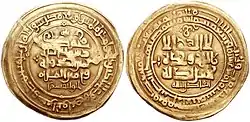
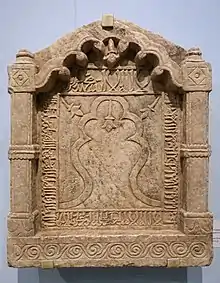
In 997, Mahmud, another son of Sebuktigin, succeeded the throne, and Ghazni and the Ghaznavid dynasty have become perpetually associated with him. He completed the conquest of the Samanid and Shahi territories, including the Ismaili Kingdom of Multan, Sindh, as well as some Buwayhid territory. By all accounts, the rule of Mahmud was the golden age and height of the Ghaznavid Empire. Mahmud carried out seventeen expeditions through northern India to establish his control and set up tributary states, and his raids also resulted in the looting of a great deal of plunder. He established his authority from the borders of Ray to Samarkand, from the Caspian Sea to the Yamuna.
During Mahmud's reign (997–1030), the Ghaznavids settled 4,000 Turkmen families near Farana in Khorasan. By 1027, due to the Turkmen raiding neighbouring settlements, the governor of Tus, Abu l'Alarith Arslan Jadhib, led military strikes against them. The Turkmen were defeated and scattered to neighbouring lands.[16] Although, as late as 1033, Ghaznavid governor Tash Farrash executed fifty Turkmen chiefs for raids into Khorasan.[17]
The wealth brought back from the Mahmud's Indian expeditions to Ghazni was enormous, and contemporary historians (e.g. Abolfazl Beyhaghi, Ferdowsi) give glowing descriptions of the magnificence of the capital and of the conqueror's munificent support of literature. Mahmud died in 1030.
Decline
Twin sons of Mahmud
Mahmud left the empire to his son Mohammed, who was mild, affectionate and soft. His brother, Mas'ud, asked for three provinces that he had won by his sword, but his brother did not consent. Mas'ud had to fight his brother, and he became king, blinding and imprisoning Mohammed as punishment. Mas'ud was unable to preserve the empire and following a disastrous defeat at the Battle of Dandanaqan in 1040, he lost all the Ghaznavid lands in Iran and Central Asia to the Seljuks, plunging the realm into a "time of troubles".[8] His last act was to collect all his treasures from his forts in hope of assembling an army and ruling from India, but his own forces plundered the wealth and he proclaimed his blind brother as king again. The two brothers now exchanged positions: Mohammed was elevated from prison to the throne, while Mas'ud was consigned to a dungeon after a reign of ten years and was assassinated in 1040. Mas'ud's son, Madood, was governor of Balkh, and in 1040, after hearing of his father's death, he came to Ghazni to claim his kingdom. He fought with the sons of the blind Mohammed and was victorious. However, the empire soon disintegrated and most kings did not submit to Madood. In a span of nine years, four more kings claimed the throne of Ghazni.
Ibrahim
In 1058, Mas'ud's son Ibrahim, a great calligrapher who wrote the Koran with his own pen, became king. Ibrahim re-established a truncated empire on a firmer basis by arriving at a peace agreement with the Seljuks and a restoration of cultural and political linkages.[8] Under Ibrahim and his successors the empire enjoyed a period of sustained tranquility. Shorn of its western land, it was increasingly sustained by riches accrued from raids across Northern India, where it faced stiff resistance from Indian rulers such as the Paramara of Malwa and the Gahadvala of Kannauj.[8] He ruled until 1098.
Mas'ud III
Mas'ud III became king for sixteen years, with no major event in his lifetime. Mas'ud built the Palace of Sultan Mas'ud III and the one of Ghazni Minarets. Signs of weakness in the state became apparent when he died in 1115, with internal strife between his sons ending with the ascension of Sultan Bahram Shah as a Seljuk vassal.[8] Bahram Shah defeated his brother Arslan for the throne at the Battle of Ghazni in 1117.
Sultan Bahram Shah
Sultan Bahram Shah was the last Ghaznavid King, ruling Ghazni, the first and main Ghaznavid capital, for thirty five years. In 1148 he was defeated in Ghazni by Sayf al-Din Suri, but he recaptured the capital the next year. Ala al-Din Husayn, a Ghorid King, conquered the city in 1151, for the revenge of his brother Kutubbuddin's death, who was son-in-law of the king but was publicly punished and killed for a minor offence. Ala al-Din Husayn then razed the city and burned it for 7 days, after which he became known as "Jahānsuz" (World Burner). Ghazni was restored to the Ghaznavids by the intervention of the Seljuks, who came to the aid of Bahram.[8] Ghaznavid struggles with the Ghurids continued in subsequent years as they nibbled away at Ghaznavid territory, and Ghazni and Zabulistan was lost to a group of Oghuz Turks before captured by the Ghurids.[8] Ghaznavid power in northwestern India continued until the Ghurid conquest of Lahore from Khusrau Malik in 1186.[8]
Military and tactics
The core of the Ghaznavid army was primarily made up of Turks,[18] as well as thousands of native Afghans who were trained and assembled from the area south of the Hindu Kush in what is now Afghanistan.[19] During the rule of Sultan Mahmud, a new, larger military training center was established in Bost (now Lashkar Gah). This area was known for blacksmiths where war weapons were made. After capturing and conquering the Punjab region, the Ghaznavids began to employ Hindus in their army.[20]
Like the other dynasties that rose out of the remains of the Abbasid Caliphate, the Ghaznavid administrative traditions and military practice came from the Abbasids. The Arabian horses, at least in the earliest campaign were still substantial in Ghaznavid military incursions especially in dashing raids deep into hostile territory. As evidenced there is a record about '6000 Arab horse' were sent against king Anandapala in 1008 AD and the existence of this Arabian cavalry persist until 1118 under the Ghaznavid governor in Lahore.[21]
Due to their access to the Indus-Ganges plains, the Ghaznavids, during the 11th and 12th centuries, developed the first Muslim army to use war elephants in battle. The elephants were protected by armour plating on their fronts. The use of these elephants was a foreign weapon in other regions that the Ghaznavids fought in, particularly in Central Asia.[22]
State and culture
According to Clifford Edmund Bosworth:
The Ghaznavid sultans were ethnically Turkish, but the sources, all in Arabic or Persian, do not allow us to estimate the persistence of Turkish practices and ways of thought amongst them. Yet given the fact that the essential basis of the Ghaznavids’ military support always remained their Turkish soldiery, there must always have been a need to stay attuned to their troops’ needs and aspirations; also, there are indications of the persistence of some Turkish literary culture under the early Ghaznavids (Köprülüzade, pp. 56–57). The sources do make it clear, however, that the sultans’ exercise of political power and the administrative apparatus which gave it shape came very speedily to be within the Perso-Islamic tradition of statecraft and monarchical rule, with the ruler as a distant figure, buttressed by divine favor, ruling over a mass of traders, artisans, peasants, etc., whose prime duty was obedience in all respects but above all in the payment of taxes. The fact that the personnel of the bureaucracy which directed the day-to-day running of the state, and which raised the revenue to support the sultans’ life-style and to finance the professional army, were Persians who carried on the administrative traditions of the Samanids, only strengthened this conception of secular power.
Persianisation of the state apparatus was accompanied by the Persianisation of high culture at the Ghaznavid court... The level of literary creativity was just as high under Ebrāhīm and his successors up to Bahrāmšāh, with such poets as Abu’l-Faraj Rūnī, Sanāʾī, ʿOṯmān Moḵtārī, Masʿūd-e Saʿd-e Salmān, and Sayyed Ḥasan Ḡaznavī.[23] We know from the biographical dictionaries of poets (taḏkera-ye šoʿarā) that the court in Lahore of Ḵosrow Malek had an array of fine poets, none of whose dīvāns has unfortunately survived, and the translator into elegant Persian prose of Ebn Moqaffaʿ’s Kalīla wa Demna, namely Abu’l-Maʿālī Naṣr-Allāh b. Moḥammad, served the sultan for a while as his chief secretary.[24] The Ghaznavids thus present the phenomenon of a dynasty of Turkish slave origin which became culturally Persianised to a perceptibly higher degree than other contemporary dynasties of Turkish origin such as Saljuqs and Qarakhanids.[8]
Persian literary culture enjoyed a renaissance under the Ghaznavids during the 11th century.[25][26][27] The Ghaznavid court was so renowned for its support of Persian literature that the poet Farrukhi traveled from his home province to work for them.[28] The poet Unsuri's short collection of poetry was dedicated to Sultan Mahmud and his brothers Nasr and Yaqub.[29] Another poet of the Ghaznavid court, Manuchehri, wrote numerous poems to the merits and advantages of drinking wine.[30]
Sultan Mahmud, modelling the Samanid Bukhara as a cultural center, made Ghazni into a center of learning, inviting Ferdowsi and al-Biruni. He even attempted to persuade Avicenna, but was refused.[31] Mahmud preferred that his fame and glory be publicized in Persian and hundreds of poets assembled at his court.[32] He brought whole libraries from Rayy and Isfahan to Ghazni and even demanded that the Khwarizmshah court send its men of learning to Ghazni.[33] Due to his invasion of Rayy and Isfahan, Persian literary production was inaugurated in Azerbaijan and Iraq.[34]
The Ghaznavids continued to develop historical writing in Persian that had been initiated by their predecessors, the Samanid Empire.[35] The historian Abu'l-Fadl Bayhaqi's Tarikh-e Beyhaqi, written in the latter half of the 11th century, is an example.[36]
Although the Ghaznavids were of Turkic origin and their military leaders were generally of the same stock, as a result of the original involvement of Sebuktigin and Mahmud of Ghazni in Samanid affairs and in the Samanid cultural environment, the dynasty became thoroughly Persianized, so that in practice one cannot consider their rule over Iran one of foreign domination. They also copied their administrative system from the Samanids.[37] In terms of cultural championship and the support of Persian poets, they were more Persian than their ethnically-Iranian rivals, the Buyid dynasty, whose support of Arabic letters in preference to Persian is well known.[38]
Historian Bosworth explains: "In fact with the adoption of Persian administrative and cultural ways the Ghaznavids threw off their original Turkish steppe background and became largely integrated with the Perso-Islamic tradition."[39] As a result, Ghazni developed into a great centre of Arabic learning.[2]
With Sultan Mahmud's invasions of North India, Persian culture was established at Lahore, which later produced the famous poet, Masud Sa'd Salman.[9] Lahore, under the Ghaznavid rule in the 11th century, attracted Persian scholars from Khorasan, India and Central Asia and became a major Persian cultural centre.[40][31] It was also during Mahmud's reign that Ghaznavid coinage began to have bilingual legends consisting of Arabic and Devanagari script.[41]
The Persian culture, established by the Ghaznavids in Ghazna and Eastern Afghanistan, survived the Ghurid invasion in the 12th century and endured until the invasion of the Mongols.[42]
Legacy
At its height, the Ghaznavid empire grew to cover large parts of present-day Iran, Turkmenistan and Uzbekistan, all of Afghanistan, Pakistan and large parts of northwest India. The Ghaznavid rulers are generally credited with spreading Islam into the Indian subcontinent. In addition to the wealth accumulated through raiding Indian cities, and exacting tribute from Indian rajas, the Ghaznavids also benefited from their position as an intermediary along the trade routes between China and the Mediterranean. They were, however, unable to hold power for long and by 1040 the Seljuks had taken over their Persian domains and a century later the Ghurids took over their remaining sub-continental lands.
List of rulers
| # | Laqab | Personal Name | Reign | Succession right | Notes |
|---|---|---|---|---|---|
| 1 | Nasir-ud-din
نصر الدين |
Sabuktigin | 977–997 | ||
| 2 | No title | Ismail | 997–998 | son of Sabuktigin | |
| 3 | Yamin ad-Dawlah Abu Qasim یمین الدولہ ابو لقاسم Right-hand man of the State |
Mahmud | 998–1030 | first son of Sabuktigin | |
| 4 | Jalal ad-Dawlah جلال الدولہ Dignity of the State |
Muhammad | 1030 1st reign |
second son of Mahmud | |
| 5 | Shihab ad-Dawlah شھاب الدولہ Star of the State |
Masud I | 1030–1041 | first son of Mahmud | Was overthrown, imprisoned and executed, following the battle of Dandanaqan |
| — | Jalal ad-Dawlah جلال الدولہ Dignity of the State |
Muhammad | 1041 2nd reign |
second son of Mahmud | Raised to the throne following the removal of Masud I. |
| 6 | Shihab ad-Dawlah شھاب الدولہ Star of the State |
Mawdud | 1041–1048 | son of Masud I | Defeated Muhammad at the battle of Nangrahar and gained the throne.[43] |
| 7 | ? ? |
Masud II | 1048 | son of Mawdud | |
| 8 | Baha ad-Dawlah بھاء الدولہ Splendor of the State |
Ali | 1048–1049 | son of Masud I | |
| 9 | Izz ad-Dawlah عز الدولہ Glory of the State |
Abd al-Rashid | 1049–1052 | fifth son of Mahmud | |
| 10 | Qiwam ad-Dawlah قوام الدولہ Support of the State |
Toghrul | 1052–1053 | Turkish mamluk general | Usurped the Ghaznavid throne after massacring Abd al-Rashid and eleven other Ghaznavid princes.[44] |
| 11 | Jamal ad-Dawlah جمال الدولہ Beauty of the state |
Farrukh-Zad | 1053–1059 | son of Masud I | |
| 12 | Zahir ad-Dawlah ظھیر الدولہ Help of the State |
Ibrahim | 1059–1099 | son of Masud I | |
| 13 | Ala ad-Dawlah علاء الدولہ Blessing of the State |
Mas'ūd III | 1099–1115 | son of Ibrahim | |
| 14 | Kamal ad-Dawlah کمال الدولہ Perfection of the State |
Shirzad | 1115–1116 | son of Masud III | Murdered by his younger brother Arslan ibn Mas'ud.[45] |
| 15 | Sultan ad-Dawlah سلطان الدولہ Sultan of the state |
Arslan-Shah | 1116–1117 | son of Masud III | Took the throne from his older brother Shirzad, but faced a rebellion from his other brother Bahram Shah, who was supported by the sultan of the Great Seljuq Empire, Ahmad Sanjar.[46] |
| 16 | Yamin ad-Dawlah یمین الدولہ Right-hand man of the state |
Bahram Shah | 1117–1157 | son of Masud III | Under Bahram-Shah, the Ghaznavid empire became a tributary of the Great Seljuq Empire. Bahram was assisted by Ahmad Sanjar, sultan of the Great Seljuq empire, in securing his throne.[39] |
| 17 | Muizz ad-Dawlah معزالدولہ Honor of the State |
Khusrau-Shah | 1157–1160 | son of Bahram-Shah | |
| 18 | Taj ad-Dawlah تاج الدولہ Crown of the state |
Khusrau Malik | 1160–1186 | son of Khusrau-Shah | |
Family tree of the Ghaznavid sultans
See also
Part of a series on the |
|---|
| History of Afghanistan |
 |
| Timeline |
| Related historical names of the region |
|
 Faravahar background |
| History of Greater Iran |
|---|
Part of a series on the |
|---|
| History of Pakistan |
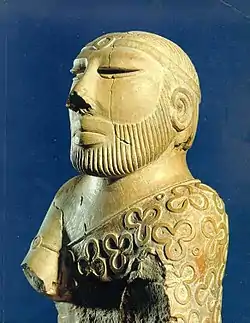 |
| Timeline |
|
Part of a series on the |
|---|
| History of Turkmenistan |
 |
| Periods |
| Related historical names of the region |
|
|
| History of the Turkic peoples pre–14th century |
|---|
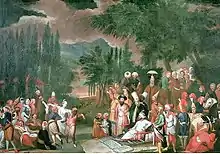 History of the Turkic peoples |
| Tiele people |
| Göktürks |
|
| Khazar Khaganate 618–1048 |
| Xueyantuo 628–646 |
| Kangar union 659–750 |
| Turk Shahi 665-850 |
| Türgesh Khaganate 699–766 |
| Kimek confederation 743–1035 |
| Uyghur Khaganate 744–840 |
| Oghuz Yabgu State 750–1055 |
| Karluk Yabgu State 756–940 |
| Kara-Khanid Khanate 840–1212 |
| Ganzhou Uyghur Kingdom 848–1036 |
| Qocho 856–1335 |
| Pecheneg Khanates 860–1091 |
| Ghaznavid Empire 963–1186 |
| Seljuk Empire 1037–1194 |
| Cuman–Kipchak confederation 1067–1239 |
| Khwarazmian Empire 1077–1231 |
| Kerait Khanate 11th century–13th century |
| Delhi Sultanate 1206–1526 |
| Qarlughid Kingdom 1224–1266 |
| Golden Horde 1240s–1502 |
| Mamluk Sultanate (Cairo) 1250–1517 |
- List of battles involving the Ghaznavid Empire
- History of Afghanistan
- List of Sunni Muslim dynasties
Notes
- "Indeed, since the formation of the Ghaznavids state in the tenth century until the fall of Qajars at the beginning of the twentieth century, most parts of the Iranian cultural regions were ruled by Turkic-speaking dynasties most of the time. At the same time, the official language was Persian, the court literature was in Persian, and most of the chancellors, ministers, and mandarins were Persian speakers of the highest learning and ability."[1]
- The Ghaznavids were a dynasty of Turkic slave-soldiers...[6]
- "The Ghaznavids inherited Samanid administrative, political, and cultural traditions and laid the foundations for a Persianate state in northern India. ..."[9]
- Nizam al-Mulk also attempted to organise the Saljuq administration according to the Persianate Ghaznavid model.[10]
References
- Katouzian 2003, p. 128.
- Bosworth 1963, p. 134.
- Turchin, Adams & Hall 2006, p. 223.
- Taagepera 1997, p. 496.
- Arjomand 2012, p. 410-411.
- Levi & Sela 2010, p. 83.
- Bosworth 1963, p. 4.
- Bosworth 2006.
- Ziad 2006, p. 294.
- Meisami 1999, p. 143.
- Spuler 1970, p. 147.
- Bosworth 1975, p. 170.
- Amirsoleimani 1999, p. 243.
- Spuler 1991, p. 1051.
- Bosworth 1968, p. 40.
- Bosworth 1963, p. 224.
- Bosworth 1963, p. 225.
- Wink 2002, p. 114.
- Houtsma 1987, p. 151.
- Roy 2016, p. 24.
- Bosworth 1963, p. 111-112.
- Lewis 1992, p. 205.
- Bosworth 1977, p. 75-77, 107-110.
- Bosworth 1977, p. 127-128.
- Bosworth 1968, p. 44.
- Sharlet 2011, p. 46.
- Rowson 1998, p. 251.
- Sharlet 2011, p. 27.
- Sharlet 2011, p. 52.
- Yarshater 1960, p. 44.
- Spooner & Hanaway 2012, p. 284.
- Notghi & Sabri-Tabrizi 1994, p. 244.
- Bosworth 1963, p. 132.
- Ahmadi 2004, p. 146.
- Meisami 1993, p. 247.
- Poliakova 1984, p. 241.
- Bosworth 1968, p. 36.
- Yarshater 2008.
- Bosworth 1996, p. 297.
- Alam, Nalini & Gaborieau 2000, p. 24.
- Bosworth 1963, p. 44.
- Bosworth 1968, p. 39.
- Bosworth 1977, p. 22-24.
- Bosworth 1977, p. 45.
- Bosworth 1977, p. 90.
- Bosworth 1977, p. 93-95.
Sources
- Ahmadi, Wali (2004). "The Institution of Persian Literature and the Genealogy of Bahar's "Stylistics"". British Journal of Middle Eastern Studies. Taylor & Francis, Ltd. 31 (2 (Nov.)).
- Alam, Muzaffar; Nalini, Françoise Delvoye; Gaborieau, Marc (2000). The making of Indo-Persian Culture: Indian and French Studies. Manohar Publishers & Distributors.
- Arjomand, Said Amir (2012). "Patrimonial state". In Böwering, Gerhard; Crone, Patricia; Mirza, Mahan (eds.). The Princeton Encyclopedia of Islamic Political Thought. Princeton University Press.
- Amirsoleimani, Soheila (1999). "Truths and Lies: Irony and Intrigue in the Tārīkh-i Bayhaqī: The Uses of Guile: Literary and Historical Moments". Iranian Studies. Taylor & Francis, Ltd. 32 (2, Spring). doi:10.1080/00210869908701955.
- Bosworth, C.E. (1963). The Ghaznavids:994–1040. Edinburgh University Press.
- Bosworth, C.E. (1968). "The Development of Persian Culture under the Early Ghaznavids". Iran. Taylor & Francis, Ltd. 6: 33–44. doi:10.2307/4299599. JSTOR 4299599.
- Bosworth, C.E. (1975). "The Early Ghaznavids". In Bosworth, C. E. (ed.). The Cambridge History of Iran. Vol. 4. Cambridge University Press.
- Bosworth, C.E. (1977). The Later Ghaznavids. Columbia University Press.
- Bosworth, C.E. (1996). The New Islamic Dynasties. Columbia University Press.
- Bosworth, C.E. (2006). "Ghaznavids". Encyclopaedia Iranica.
- Houtsma, Martijn Theodoor (1987). E.J. Brill's first encyclopaedia of Islam, 1913–1936. 2. BRILL. p. 151. ISBN 978-90-04-08265-6. Retrieved 24 September 2010.
- Katouzian, Homa (2003). Iranian history and politics:The Dialectic of State and Society. Routledge.
- Levi, Scott Cameron; Sela, Ron, eds. (2010). Islamic Central Asia: an anthology of historical sources. Indiana University Press.
- Lewis, Bernard (1992). The World of Islam. London: Thames and Hudson. ISBN 978-0-500-27624-2.
- Meisami, J. S. (1993). "The Past in Service of the Present: Two Views of History in Medieval Persia". Poetics Today:Cultural Processes in Muslim and Arab Societies: Medieval and Early Modern Periods. Duke University Press. 14 (2, (Summer)).
- Meisami, Julie Scott (1999). Persian historiography to the end of the twelfth century. Edinburgh University Press.
- Notghi, Hamid; Sabri-Tabrizi, Gholam-Reza (1994). "Hail to Heydarbaba: A Comparative View of Popular Turkish & Classical Persian Poetical Languages". British Journal of Middle Eastern Studies. Taylor & Francis, Ltd. 21 (2): 240–251. doi:10.1080/13530199408705603.
- Poliakova, E. A. (1984). "The Development of a Literary Canon in Medieval Persian Chronicles: The Triumph of Etiquette". Iranian Studies. Taylor & Francis, Ltd. 17 (2/3 (Spring – Summer)): 237–256. doi:10.1080/00210868408701630.
- Rowson, E.K. (1998). "Ghaznavids". In Meisami, Julie Scott; Starkey, Paul (eds.). Encyclopedia of Arabic Literature. Vol.1. Routledge.
- Roy, Kaushik (2016). Military Manpower, Armies and Warfare in South Asia. Routledge.
- Sharlet, Jocelyn (2011). Patronage and Poetry in the Islamic World: Social Mobility and Status in the Medieval Middle East and Central Asia. Tauris Academic Studies.
- Spooner, Brian; Hanaway, William L. (2012). Literacy in the Persianate World: Writing and the Social Order. University of Pennsylvania Press.
- Spuler, B. (1970). "The Disintegration of the Caliphate in the East". In Holt, P.M.; Lambton, Ann K.S.; Lewis, Bernard (eds.). Cambridge History of Islam. IA: The Central islamic Lands from Pre-Islamic Times to the First World War. Cambridge University Press.
- Spuler, B. (1991). "Ghaznawids". In Lewis, B.; Pellat, C.; Schacht, J. (eds.). The Encyclopedia of Islam. II. Brill.
- Taagepera, Rein (1997). "Expansion and Contraction Patterns of Large Polities: Context for Russia". International Studies Quarterly. Wiley. 41 (3):(September) (3): 475–504. doi:10.1111/0020-8833.00053.
- Turchin, Peter; Adams, Jonathan M.; Hall, Thomas D (2006). "East-West Orientation of Historical Empires". Journal of World-Systems Research. University of Pittsburgh Press. 12 (2):(December). ISSN 1076-156X.
- Wink, Andre (2002). Al-Hind: The Making of the Indo-Islamic World. Vol.2. Brill.
- Yarshater, E. (1960). "The Theme of Wine-Drinking and the Concept of the Beloved in Early Persian Poetry". Studia Islamica. Brill. No. 13.
- Yarshater, Ehsan (2008). "Iran". Encyclopaedia Iranica.
- Ziad, Homayra (2006). "Ghaznavids". In Meri, J. (ed.). Medieval Islamic Civilization: An Encyclopedia. Routledge.
Further reading
- Bosworth, Clifford Edmund (1963) The Ghaznavids: Their Empire in Afghanistan and Eastern Iran 994–1040 Edinburgh University Press, Edinburgh, OCLC 3601436
- Bosworth, Clifford Edmund (1977) The Later Ghaznavids: Splendour and Decay, The Dynasty in Afghanistan and Northern India 1040–1186 Columbia University Press, New York, ISBN 0-231-04428-3
- Bosworth, Clifford Edmund (1998), "THE GHAZNAVIDS", in Asimov, M.S.; Bosworth, C.E. (eds.), History of Civilisations of Central Asia (PDF), UNESCO Publishing, ISBN 978-92-3-103467-1
- M. Ismail Marcinkowski (2003) Persian Historiography and Geography: Bertold Spuler on Major Works Produced in Iran, the Caucasus, Central Asia, India and Early Ottoman Turkey Pustaka Nasional, Singapore, ISBN 9971-77-488-7
External links
| Wikimedia Commons has media related to Ghaznavid Empire. |
| Wikiquote has quotations related to: Ghaznavids |
- Mahmud of Ghazna Columbia Encyclopedia (Sixth Edition)
- Mahmud Encyclopædia Britannica (Online Edition)
- Ghaznavid Dynasty Encyclopædia Britannica (Online Edition)
- Ghaznavids and Ghurids Encyclopædia Britannica (Online Edition)
- Mahmud Ghaznavi's 17 invasions of India
- The History of India, as Told by Its Own Historians. The Muhammadan Periodby Sir H. M. Elliot; Edited by John Dowson; London Trubner Company 1867–1877 Elliot, Sir H. M., Edited by Dowson, John. The History of India, as Told by Its Own Historians. The Muhammadan Periodpublished by London Trubner Company 1867–1877. (Online Copy: – Online version posted by: The Packard Humanities Institute; Persian Texts in translation)
- Afghan secrets revealed on Google Earth
- Ethé, Karl Hermann (1911). . In Chisholm, Hugh (ed.). Encyclopædia Britannica. 21 (11th ed.). Cambridge University Press. pp. 187–252.
